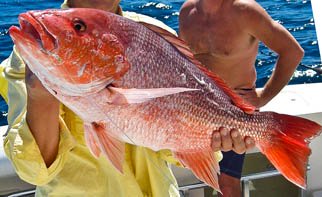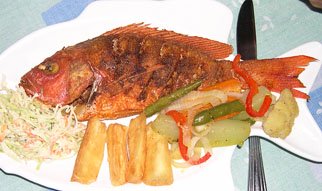Northern red snapper Nutrition facts
The Northern red snapper is one of the most attractive temperate water marine fish popular for its juicy, white, fine-flavored flesh. Red snapper is a temperate water marine fish and one of the most popular food fish caught in the Southern states of the US.
Scientific name. Lutjanus campechanus. Family: Lutjanidae.
Other common names: Spot snapper, American snapper, gulf red snapper, American red snapper, acara aya, pargo colorado, huachinango del golfo (Spanish), luciano-do-golfo (Portuguese), pargre fine (French), pargo (Papiamento), etc.
 |
| Northern red snapper (Lutjanus campechanus). Photo credit: extra zebra. |
Description
Red snappers are deep-bodied fish with scarlet red upper body and angular fins and a paler underside. The mouth is large with sharp teeth. Eyes are red. Juvenile red snappers exhibit a dark spot on the upper sides below the anterior soft dorsal rays that disappear as they grow into adults.
The adult northern red snapper reaches an average length of 24 inches and may weigh 5-15 pounds. Sexual maturity is reached at 2 years. The maximum age is estimated at 40-50 years.
Lane snapper (Lutjanus synagris) has a similar body shape and color, but it also has eight narrow yellow lines that run the length of the fish. It also has a black spot on each side lane snapper has a rounded anal fin.
Habitat
Red snapper lives in the subtropical continental shelves bordering the Gulf of Mexico and the Atlantic Coast as far as North Carolina, over deep reefs and rocky bottoms at depths of 50-620 feet.
Northern red snappers are carnivorous and bottom-oriented predators. They feed on zooplankton, fish eggs, worms, shrimp, and squid. Big adults prey on smaller fishes, which they find in flat bottom areas adjacent to the reefs.
Biology
In the initial years of their life, red snappers grow quickly, and then their growth slows steadily as they reach full-size adult fish. They attain sexual maturity at about 2-3 years and 375 mm in fork length. Spawning occurs during summer in areas away from reefs, at depths of 60-120 feet over flat sandy bottom areas. As the juveniles mature, they move to the reefs where they stay as adults.
Life span is about 20 years.
Health benefits of Northern red snapper
Red snapper fish is a non-oily, marine, white fish. It is an average source of omega fatty acids, protein, minerals, and fat-soluble vitamins like vitamins A, E, and D.
Red snapper holds 100 calories per 3.5 oz. American Heart Association (AHA) recommends the consumption of one to two meals of non-fried fish to fulfill requirements of essential fatty acids, protein, minerals, and fat-soluble vitamins.
Red snapper is excellent source of protein (20.5 g/3.5 oz -36.6% of RDI). Its white, flaky meat is firm and composes all the essential amino acids in the right proportions.
Its lean white meat is a good source of polyunsaturated fatty acids (PUFA). Studies suggest a diet rich in fish that are high in omega-3 fatty acids can curb or prevent cognitive decline, dementia, depression, neuropsychiatric disorders, asthma, and inflammatory disorders.
It is a moderate source of omega-3 eicosapentaenoicacid (EPA), docosapantaenoicacid (DPA) and docosahexaenoic acid (DHA) fatty acids. Research studies suggest that these fatty acids, particularly DHA, play an important role in the development of the nervous system, especially in infants and children.
According to Cornell University and the New York Sea Grant Extension Program. 2012- The fatty acids play a crucial role in decreasing blood pressure and heart rate and help improve cardiovascular function. For example, research has shown that omega-3 fatty acids decrease the risk of arrhythmias (abnormal heartbeats) that can lead to sudden death.
100 g of red snapper holds 408 IU of vitamin-D; about 68% of daily recommended intake. Vitamin D plays an important role in the calcium metabolism and offers protection from cancers.
It composes small amounts of vitamin-A (106 IU/3.5 oz) in its flesh; Nonetheless, it composes moderate amounts of omega-3 essential fatty acids such as ALA, DHA, and DPA which help maintain healthy mucosa and skin.
Red snapper compose several vital B-complex vitamins such as pyridoxine-36% RDA, and vitamin-B12 (3 μg-125% RDA). It is also a good source of niacin, thiamin, vitamin-E, and riboflavin.
Furthermore, red snappers compose significant amounts of minerals including potassium, calcium, phosphorus, and magnesium. The other trace elements commonly found in this fish are selenium and iodine. Iodine is an important trace element in human nutrition and is essential for thyroid hormone production.
Northern red snapper contains 0.166 ppm of methyl-mercury in its flesh. US FDA categorizes red snapperfish in the "good choice" section considering mercury levels in its flesh. The recommendation is consumption of 1 serving (1 serving = 4 ounces) per week for red snapper.
| Principle | Nutrient Value | Percent of RDA |
|---|---|---|
| Energy | 100 Kcal | 5% |
| Carbohydrates | 0 g | 0% |
| Protein | 20.5 g | 36.6% |
| Total Fat | 1.34 g | 7% |
| Cholesterol | 37 mg | 12% |
| Dietary Fiber | 0 g | 0% |
| Vitamins | ||
| Folate total | 5 μg | 1.25% |
| Niacin | 0.284 mg | 2% |
| Pyridoxine | 0.400 mg | 31% |
| Riboflavin | 0.003 mg | <1% |
| Thiamin | 0.046 mg | 4% |
| Vitamin-A | 106 IU | 3.5% |
| Vitamin-B12 | 3 μg | 125% |
| Vitamin-D | 408 IU | 68% | Electrolytes |
| Sodium | 64 mg | 4% |
| Potassium | 417 mg | 9% |
| Minerals | ||
| Calcium | 32 mg | 3.2% |
| Iron | 0.18 mg | 2% |
| Magnesium | 32 mg | 8% |
| Phosphorus | 198 mg | 28% |
| Selenium | 38.2 mg | 69% |
| Zinc | 0.36 mg | 3% | Omega-3 fatty acids (PUFA) |
| EPA (20:5 n-3) | 0.051 g | -- |
| DPA (22:5 n-3) | 0.065 g | -- |
| DHA (22:6 n-3) | 0.026 g | -- |
Buying
Red snapper is available year-round in all parts of the US. Most commercial fishing is done with baited hooks and lines on electric and hydraulic reels. The fish is sold in several market forms including whole fresh, fresh dressed, fresh fillets, frozen fillets, and frozen portions.
If buying from fishmongers, look for its fresh smell and not fishy, or ammonia-like. The gills should be red, moist, and bright. The eyes should be red, full, shiny, and flush with the head. The skin should be glistening, pearly, tight, and adhere to the flesh. The flesh should be firm and elastic; it should not be marked, retain finger impressions, or separate easily from the bones.
Avoid snapper with a strong fishy odor. They spoil quickly, so always store them in the freezer section of the home refrigerator.
Preparation
Northern red snapper has long been considered one of the most delicious marine fish in the Southern US states of Florida and Texas. Its flesh is firm, white, succulent, and flavorful that can be made use of in a host of imaginative ways of delicious dishes.
If you are buying whole fish, ask the fishmonger to do scaling, gutting, and cutting up the snapper into fillets. You also need to remove stiff bones from the center of the meat.
Red snapper can be served pan-fried, grilled, roasted, broiled, baked, and steamed.
 |
| Northern Red snapper recipe. Photo credit: dani0010. |
Baked snapper with sour cream stuffing - combine the sour cream, mayonnaise, green onions, 1 tsp lemon juice, 1/4 tsp salt, and 1/8 tsp ground red pepper. Once the fish flakes easily, spoon the sour cream mixture evenly over the fish.
Sprinkle with the shredded cheese. Bake, uncovered, for an additional 3 to 4 minutes or until the cheese melts and the sauce is thoroughly heated.
Roast spicy mixture-coated red snapper fillets in a large cast-iron skillet over high heat until the fish is deeply browned. The spice mixture employed here is paprika, cayenne, black pepper, onion powder, thyme, basil, garlic, and oregano.
Prepare Spanish style marinated red snapper cooked in a sweet-and-sour and colored with pimentón (Spanish paprika) and other spices.
It is a popular kind of white fish for fish tacos. However, halibut, tilapia, cod, bass, and catfish can be used as substitutes for snappers.
Safety profile
The mean methyl-mercury concentration in northern red snapper is 0.166 ppm. Accordingly, the U.S. FDA's final guidelines on how much fish expectant as well as breastfeeding mothers can eat, along with lists of specific options that are safe or should be avoided, place it in the "good choice" category. By this yardstick, they can consume 1 serving (4 ounces) of this fish per week.
Ciguatera toxin poisoning sometimes occurs after consuming red snapper, whose flesh was contaminated by certain toxic algae. Ciguatera toxin does not get destroyed by cooking. Symptoms may include itchiness, diarrhea, vomiting, numbness, dizziness, and muscle weakness. Only symptomatic treatment is possible.
Also read ≻≻-
≻≻- Atlantic cod nutrition facts and health benefits.
≻≻- Channel catfish nutrition facts and health benefits.
≻≻- Halibut nutrition facts and health benefits.
≻≻-Back to Seafood from Northern red snapper nutrition facts and health benefits.
Further reading (Links opens in new window):
Florida museum-Lutjanus campechanus.
Omega-3 Fatty Acids: An Essential Contribution.
New AHA guidelines recommend eating fish twice a week to improve heart health.